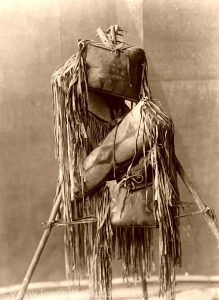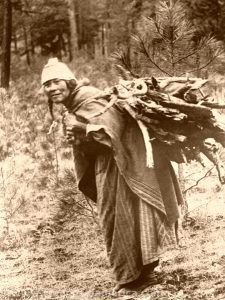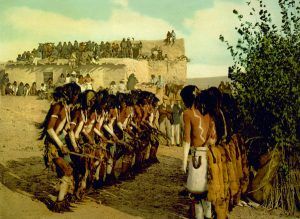Native American Medicine – Legends of America (original) (raw)
“… everything on the earth has a purpose, every disease an herb to cure it, and every person a mission. This is the Indian theory of existence.”
— Mourning Dove, Salish, 1888-1936
The healing traditions of Native Americans go back for thousands of years, as the many indigenous tribes of North America learned that by mixing herbs, roots, and other natural plants, they could heal various medical problems. But, remedies were not the only part of the Native American healing process.
With more than 2,000 tribes of indigenous people in North America, the healing practices varied widely from tribe to tribe, involving various rituals, ceremonies, and a diverse wealth of healing knowledge. While there were no absolute healing standards, most tribes believed that health was an expression of the spirit and a continual process of staying strong spiritually, mentally, and physically. This strength and keeping in harmony with themselves, those around them, their natural environment, and their Creator would keep away illness and harm. Each person was responsible for their health, and all thoughts and actions had consequences, including illness, disability, bad luck, or trauma. Only when harmony was set right could their health be restored.
Herbal remedies filled an essential role within these healing practices, stretching beyond the body’s aches and pains and into the realm of spirituality and harmony.
The herbs and other natural products used in remedies were generally gathered from their surrounding environment, resulting in various cures. However, sometimes items that were unavailable locally were traded over long distances. Herbs and medicinal plants were often seen as deeply sacred.
Many of the various practices have been passed down orally from generation to generation and never documented in writing, leaving many healing remedies a mystery. Only rarely did the healers, such as the Cherokee, who developed a written language, put their formulas or practices in writing.
When early Europeans arrived in the United States more than 500 years ago, they were surprised to see Native Americans recovering from illnesses and injuries that they considered fatal. The Indians’ herbal remedies were far superior to those known to the new immigrants in many ways. But, the Native Americans had no remedies for the “diseases of civilization” or white man’s diseases, such as measles and smallpox, which would wipe out thousands of them over the next few centuries. Not only lost were these many Native Americans, but also bodies of knowledge that went to the grave with healers. Despite the loss of some of the information, much of it has survived, utilized by Native Americans and non-natives alike. Many modern medicines are based on plants and herbs that Indians used for thousands of years. More than 200 botanicals, derived originally from Native Americans, have been or are still used in pharmaceuticals.
Spirituality and Connection:
The major difference between Native American healing and conventional medicine, both in the past and present, is the role of spirituality in the healing process. Native Americans believe that all things in nature are connected and that spirits can promote health or cause illness. Therefore, it is necessary to heal the physical parts of an individual and their emotional wellness and harmony with their community and the environment around them. In addition to herbal remedies, the community often came together to help an ill person in ceremonies, dances, praying, and chanting.
Today, modern medicine focuses only on science and the mechanistic view of the body, while many Native Americans continue to include the spirit as an inseparable healing element.
Healers:
Native American Medicine bags, Edward S. Curtis, 1910.
Referred to as healers, Medicine Men, or Medicine Women by their tribes, they have also been called “Shamans” by people of European descent, though the Native Americans did not use this term. These many healers’ primary role was to secure the help of the spirit world, especially the “Creator” or “Great Spirit,” for the benefit of the community or an individual.
The Medicine Man was also a priest in addition to being a doctor. Believing that disease could be caused by human, supernatural, or natural causes, the healer was equipped to treat illness in any of these categories. Masks, which were often grotesque and hideous, were worn by healers to frighten away the spirit causing the disease or pain. Beating drums and shaking rattles while dancing around the patient was also used to exorcise the demons. The Medicine Man combined the rights of exorcism with other practical procedures, using plant and animal substances. In addition to herbal remedies, suction tubes or cups were also used by many healers and purging and purification.
Medicine people were often born into a family with many generations of medicine people. Others may have had a vision that led them to study medicine. Those who wished to become healers would first serve a long apprenticeship with an experienced medicine person before being qualified to act alone.
Always a respected member of their tribes, being a medicine person was a full-time job, ensuring the well-being and balance of both individuals and the tribe itself. In return for their services, the healer was provided for in all ways, including food, shelter, and any assistance that might be needed. Gifts were given to the healer for services rendered, which might include a wide variety of skills such as herbal medicine, bone-setting, midwifery, and counseling.
Medicine Woman.
Tools were used by the healers made from nature, including fur, skins, bone, crystals, shells, roots, and feathers. These were used to evoke the spirit of what the tool was made, calling for the assistance of the spirits of the tree or animal from which the tool was made. Feathers, linked to the air and wind, were often used to carry the message to the Great Spirit. In some cases, the healer may go into a trance state and seek the help of “spirit guides.”
Inherited conditions such as birth defects or retardation were generally not treated. Other conditions were also not always treated if the medical person felt it resulted from a patient’s behavior and was a life lesson that needed to be learned.
Healers kept their remedies and tools in a medicine bundle, made from cloth or hide tied securely. There were several types of bundles – the healer’s personal bundles, the tribe’s, and bundles utilized for special purposes, such as festivals and ceremonies. The contents of each medicine bundle are sacred, and asking about the contents of a personal bundle was generally forbidden. Medicine bundles belonging to tribes were sometimes called “grandmothers” because of the power they held to nourish and nurture the group. One tool often found in medicine bundles is medicine pipes, representing the ebb and flow of life. It is believed that the exhaled smoke carries prayers up to the Great Spirit.
One aspect of the healing practices with individuals is that it was considered a private matter between the healer and the patient. In addition, the patient’s preferences are always respected within their cultural traditions.
Healing Rituals and Ceremonies:
Symbolic healing rituals and ceremonies were often held to bring participants into harmony with themselves, their tribe, and their environment. Ceremonies were used to help groups of people return to harmony but not used for individual healing. Varying widely from tribe to tribe, some tribes, such as the Sioux and Navajo, used a medicine wheel, a sacred hoop, and singing and dancing in ceremonies that might last for days.
For individuals, healers might also use dancing, painting, changing, drumming, feathers, and rattles in their rituals. Sometimes sacred stones were rubbed over the part of the person’s body.
Native Americans often utilized sweat lodges or sweat baths for purification and purging. Used for healing and balancing, it also was thought to help rid evils and revitalize the body.
These baths could range from simply laying under a blanket in the hot sun to small conical structures covered by branches and blankets or hides. Hot stones were covered with water to create a steam bath inside the lodge, and here the healer might pray, sing, or drum together to purify the spirits.
Sweat lodges were utilized for multiple purposes, sometimes to help heal an individual, sometimes for greater numbers of people before spiritual ceremonies, or to bring clarity to a problem. In some cultures, sage, the strongest cleansing herb, was burned until it smoldered and gave off clouds of smoke. Called “sweeping the smoke,” it was smudged onto the skin and was thought to purify the body and soul.
Banning of Religious Rights:
In 1882, the Federal Government began to ban Native American Religious Rights, which also impacted their medical practices. U.S. Interior Secretary Henry M. Teller ordered an end to all “heathenish dances and ceremonies” on reservations due to their “great hindrance to civilization.” This was further supported the following year by Hiram Price, Commissioner of Indian Affairs, when his 1883 report stated:
“…there is no good reason why an Indian should be permitted to indulge in practices which are alike repugnant to common decency and morality; and the preservation of good order on the reservations demands that some active measures should be taken to discourage and, if possible, put a stop to the demoralizing influence of heathenish rites.”
These attempts to suppress the traditions of Native Americans eventually led to the Massacre at Wounded Knee on December 29, 1890, when the government attempted to stop the practice of the “Ghost Dance,” a far-reaching movement that prophesied a peaceful end to white American expansion and preached goals of clean living, an honest life, and cross-cultural cooperation by Native Americans. When the Seventh U.S. Cavalry was sent into the Lakota Sioux’s Pine Ridge and Rosebud Reservations to stop the dance and arrest the participants., approximately 150 Native American men, women, and children were killed.
Though charges of killing innocents were brought against members of the Seventh Calvary, all were exonerated. Just two years later, further measures were taken to suppress Native religions when Commissioner of Indian Affairs Thomas J. Morgan ordered penalties of up to six months in prison for those who repeatedly participated in religious dances or acted as medicine men. However, these new laws were almost impossible to enforce, and the Native Americans continued their customs.
Before 1900, Native Americans depended on their medicine people for all illnesses and injuries. However, that began to change in the early 20th century as hospitals and clinics were opened by the Indian Health Service. Though the old traditions of spiritual harmony remained a part of their culture, many Native Americans began to use modern medicine, especially in helping to heal “white-man” diseases, for which their healers had no medicine.
Amazingly, the ban against Native American spiritual rituals continued to be in place until the 1978 passage of the American Indian Religious Freedom Act. Unfortunately, due to the decades of the ban, many Native American healing practices were driven underground or lost entirely.
Today, many tribes continue to guard the knowledge of their medicine people and will not discuss the topic with non-Indians. Some believe that sharing healing knowledge will weaken the spiritual power of medicine.
Native American Medicine Today:
Today, the tide of medical theory has begun to swing back towards an approach that recognizes and respects every aspect of the individual, including their mental and spiritual states. As a result, Native American medical practices are becoming popular with natives and non-natives alike.
Many are concerned about pharmaceutical products’ toxicity, addictive properties, and side effects and turn to natural herbal remedies. Quality Native American products have often been developed and used over many centuries to deal with various illnesses. While not universally true, herbal remedies tend to be far less toxic and have fewer unpleasant side effects than many prescription drugs. When choosing herbal remedies, look for carefully controlled and formulated products that use the highest quality organic ingredients and strict pharmaceutical levels of manufacturing.
Like any other medication, herbal products should be used appropriately. Follow directions and use them correctly and at the proper dosage level.
Antelope priests chanting at Kisi Moki snake dance, Hopi, Detroit Photographic, 1902
© Kathy Alexander/Legends of America, updated December 2021.
Also See:
Native Americans – First Owners of America


